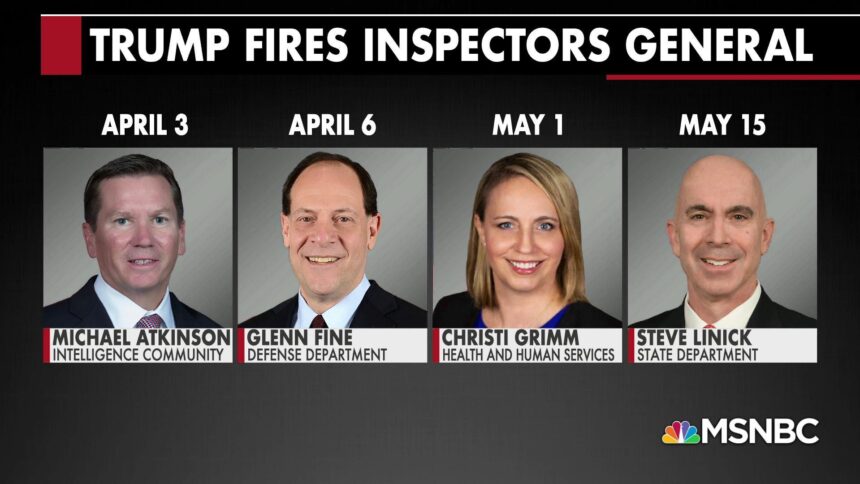A federal judge has ruled that former President Donald Trump violated the law by firing several inspectors general during his governance, yet allowed the dismissals to remain in effect. The decision highlights legal limits on presidential authority over watchdog officials tasked with government oversight but stops short of reinstating the ousted inspectors. The ruling underscores ongoing tensions over executive power and accountability in the Trump era.
Judge Rules Trump Broke Law in Removal of Inspectors General
In a significant legal development, a federal judge has determined that former President Donald Trump unlawfully removed several inspectors general during his tenure, breaching federal statutes designed to protect the independence of these watchdog officials. Despite this legal finding, the court ruled that the dismissals will not be reversed, allowing the changes in oversight to remain in place. This ruling highlights ongoing tensions between executive authority and accountability mechanisms embedded within government oversight.
- Legal Violation: The judge concluded that the removals bypassed required procedural safeguards.
- Impact on Oversight: The inspectors general play a crucial role in investigating government misconduct.
- Court’s Ruling: While violations were confirmed, the remedy to reinstate the officials was denied.
| Inspector General | Agency | Date of Removal |
|---|---|---|
| Michael Atkinson | Intelligence Community | April 2020 |
| Glenn Fine | Department of Defense | July 2020 |
| Steve Linick | Department of State | May 2020 |
Legal Implications for Executive Authority and Oversight Protections
The recent judicial ruling underscores a complex intersection of presidential authority and statutory safeguards designed to ensure accountability within federal agencies. While the court acknowledged that the former president violated provisions established to protect inspectors general from unjustified dismissal, it stopped short of overturning the personnel changes. This nuanced decision reflects judicial restraint in balancing the executive branch’s power with legislative oversight mechanisms.
Key legal considerations highlighted include:
- Statutory Protections: Inspectors general (IGs) are shielded by laws requiring just cause and a 30-day notice period to Congress before removal, aimed at preserving their independence.
- Executive Discretion vs. Accountability: The ruling emphasizes that while the president possesses broad removal authority, it is indeed not absolute and must adhere to constraints ensuring IGs can perform unbiased oversight.
- Precedential Impact: This decision could influence future cases involving checks on executive actions affecting oversight officials, highlighting the judiciary’s role in enforcing administrative integrity.
| Legal Aspect | Implication | Outcome |
|---|---|---|
| IG Removal Protections | Ensures IG autonomy | Violated but dismissal upheld |
| Congressional Notification | Mandates 30-day advance notice | Not properly observed |
| Judicial Restraint | Limits court intervention in executive decisions | Allowed dismissal to stand |
Impact of Ruling on Future Presidential Actions Regarding Oversight Officials
The ruling establishes a pivotal precedent emphasizing that while a president retains the authority to remove inspectors general, such actions must strictly adhere to legal stipulations designed to ensure oversight independence. Future administrations will face heightened scrutiny when contemplating dismissals of oversight officials, as courts may now be more inclined to evaluate the motives behind such decisions. This judicial position underscores the delicate balance between executive privilege and the necessity for accountable governance.
- Legal Boundaries Reinforced: Presidents must provide valid, non-retaliatory reasons for removing inspectors general, aligning with statutory protections.
- Enhanced Judicial Oversight: Courts may play an active role in assessing whether dismissals undermine oversight functions.
- Deterring Arbitrary Firings: The ruling acts as a deterrent against misuse of power for political or personal gain.
| Potential Future Scenarios | Implications |
|---|---|
| Removal with Explicit Cause | Likely to withstand legal challenge if reasons are well-documented. |
| Removal Without Description | High risk of judicial reversal or reinstatement demands. |
| Politically Motivated Firings | Increased litigation and possible congressional inquiries. |
This decision signals to future administrations that while the executive branch holds significant discretion in personnel decisions, it is not unfettered. The integrity of oversight mechanisms depends on impartial and lawful administration, which this ruling actively safeguards.Consequently, presidents may adopt more cautious approaches, engaging in dialog with congressional watchdogs and ensuring transparency to fortify the credibility of their actions concerning inspectors general.
Recommendations for Strengthening Inspector General Independence and Enforcement
Ensuring the autonomy of Inspectors General (IGs) requires statutory safeguards that limit executive interference. One effective approach is to codify a mandatory, transparent justification process for any proposed IG removal, including a formal review by an independent congressional committee. Legislation should also establish fixed terms for IGs, making arbitrary firings more difficult and deterring politically motivated dismissals. Additionally, enhancing whistleblower protections for IGs and their staff will promote accountability and encourage robust investigations without fear of retaliation.
To bolster enforcement mechanisms, Congress could empower IG offices with independent budget control, minimizing reliance on executive branch funding approvals.Supplementing these measures,routine audits and public reporting requirements would create increased oversight of IG activities and firings. The table below highlights key policy proposals that could transform the IG framework into a stronger,more impartial watchdog system.
| Policy Proposal | Impact |
|---|---|
| Fixed Term Limits for IGs | Reduces arbitrary dismissals |
| Mandatory Congressional Review | Increases accountability |
| Independent Budget Authority | Limits executive control |
| Enhanced Whistleblower Protections | Protects investigative integrity |
| Public Reporting of Dismissals | Promotes transparency |
Key Takeaways
The ruling marks a significant judicial rebuke of former President Trump’s actions, underscoring the legal boundaries surrounding the removal of inspectors general. While the court found that the firings violated established law, it stopped short of reinstating the dismissed officials, leaving a complex legacy for oversight and accountability in government.As the decision reverberates through political and legal circles, it highlights ongoing debates about executive authority and the mechanisms designed to ensure transparency and integrity within federal agencies.
